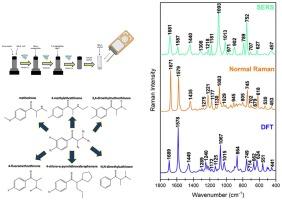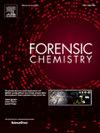Detection of synthetic cathinones in seized drugs using surface-enhanced Raman spectroscopy (SERS)
IF 2.6
3区 医学
Q2 CHEMISTRY, ANALYTICAL
引用次数: 0
Abstract
There is need for a screening method to assist authorities in detecting cathinone analogs in a rapid, reliable, and sensitive fashion. This work describes the development of Ag colloidal systems for use as SERS-enhancing substrates to detect six synthetic cathinone analogs. Furthermore, specific interactions between the analyte and metal surface were probed by determining the effect of functional groups attached to the core synthetic cathinone. Initial work involved Density Functional Theory (DFT) calculations at B3LYP/6-311G** level to predict Raman frequencies of the studied compounds. Normal Raman measurements on dried solid residues of synthetic cathinone standards were next examined, and the resulting scaled spectra were used to ensure concordance of the DFT-predicted frequencies with experimental values. Subsequent work focused on the development of a SERS protocol, which included the selection of nanoparticles in solution, followed by the addition of aggregating agents such as MgCl2 and KBr to produce high-density hot-spots on the nanometallic surface. Sample treatment conditions necessary to detect the selected synthetic cathinone analogs were also optimized. Once completed, the characterization and identification of the main peaks that make up the synthetic cathinone core structure were assigned and unique functional groups for each of the analogs were identified. Overall, the analytical process takes less than a minute, making the procedure useful for field screening. Ultimately, this procedure can aid law enforcement and first responders by providing a more specific method for rapid and sensitive on-site analysis of seized drugs.

利用表面增强拉曼光谱(SERS)检测缉获药物中的合成卡西酮类化合物
需要一种筛选方法来协助有关部门以快速、可靠和灵敏的方式检测卡西酮类似物。这项工作描述了开发银胶体系统作为 SERS 增强底物来检测六种合成卡西酮类似物的情况。此外,还通过确定附着在核心合成卡西酮上的官能团的影响,探究了分析物与金属表面之间的特定相互作用。最初的工作包括在 B3LYP/6-311G** 水平上进行密度泛函理论(DFT)计算,以预测所研究化合物的拉曼频率。接下来,对合成卡西酮标准的干燥固体残留物进行了正常拉曼测量,并使用由此产生的缩放光谱来确保 DFT 预测频率与实验值一致。随后的工作重点是开发 SERS 方案,包括选择溶液中的纳米粒子,然后加入 MgCl2 和 KBr 等聚集剂,在纳米金属表面产生高密度热点。此外,还对检测所选合成卡西酮类似物所需的样品处理条件进行了优化。完成后,对构成合成卡西酮核心结构的主峰进行了特征描述和鉴定,并确定了每种类似物的独特官能团。总体而言,分析过程耗时不到一分钟,因此可用于现场筛选。最终,该程序可以帮助执法人员和急救人员,为快速灵敏地现场分析缉获的毒品提供更具体的方法。
本文章由计算机程序翻译,如有差异,请以英文原文为准。
求助全文
约1分钟内获得全文
求助全文
来源期刊

Forensic Chemistry
CHEMISTRY, ANALYTICAL-
CiteScore
5.70
自引率
14.80%
发文量
65
审稿时长
46 days
期刊介绍:
Forensic Chemistry publishes high quality manuscripts focusing on the theory, research and application of any chemical science to forensic analysis. The scope of the journal includes fundamental advancements that result in a better understanding of the evidentiary significance derived from the physical and chemical analysis of materials. The scope of Forensic Chemistry will also include the application and or development of any molecular and atomic spectrochemical technique, electrochemical techniques, sensors, surface characterization techniques, mass spectrometry, nuclear magnetic resonance, chemometrics and statistics, and separation sciences (e.g. chromatography) that provide insight into the forensic analysis of materials. Evidential topics of interest to the journal include, but are not limited to, fingerprint analysis, drug analysis, ignitable liquid residue analysis, explosives detection and analysis, the characterization and comparison of trace evidence (glass, fibers, paints and polymers, tapes, soils and other materials), ink and paper analysis, gunshot residue analysis, synthetic pathways for drugs, toxicology and the analysis and chemistry associated with the components of fingermarks. The journal is particularly interested in receiving manuscripts that report advances in the forensic interpretation of chemical evidence. Technology Readiness Level: When submitting an article to Forensic Chemistry, all authors will be asked to self-assign a Technology Readiness Level (TRL) to their article. The purpose of the TRL system is to help readers understand the level of maturity of an idea or method, to help track the evolution of readiness of a given technique or method, and to help filter published articles by the expected ease of implementation in an operation setting within a crime lab.
 求助内容:
求助内容: 应助结果提醒方式:
应助结果提醒方式:


